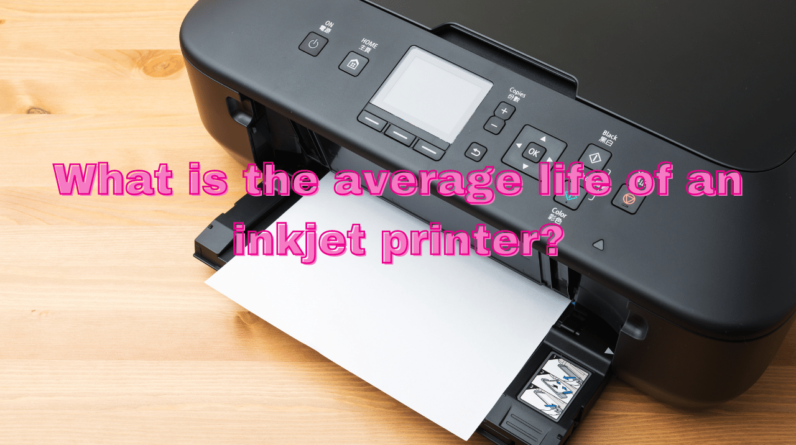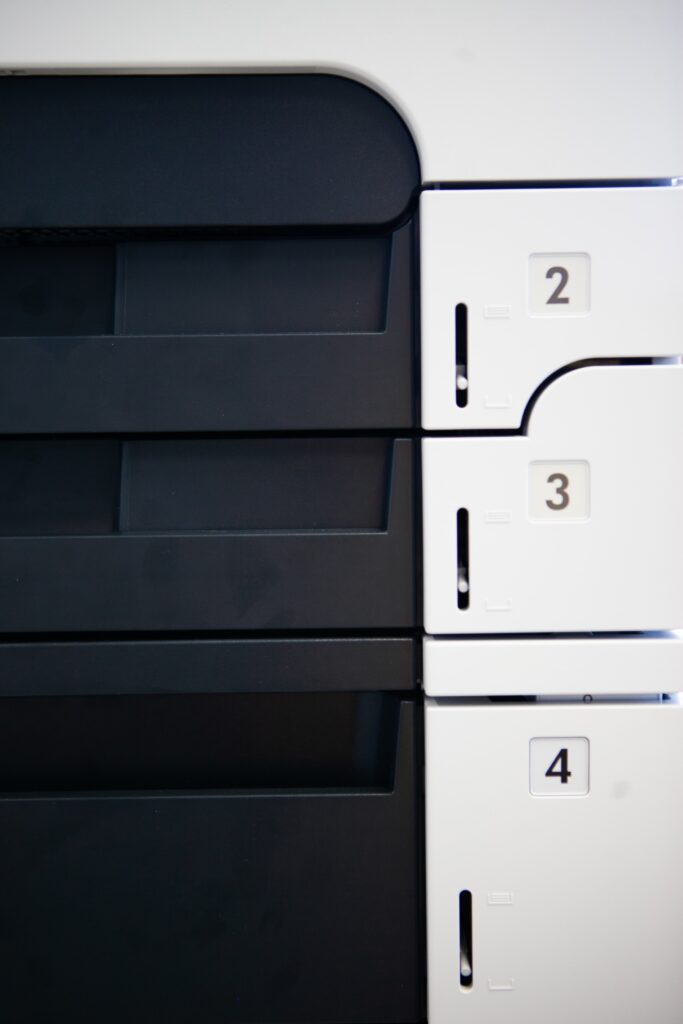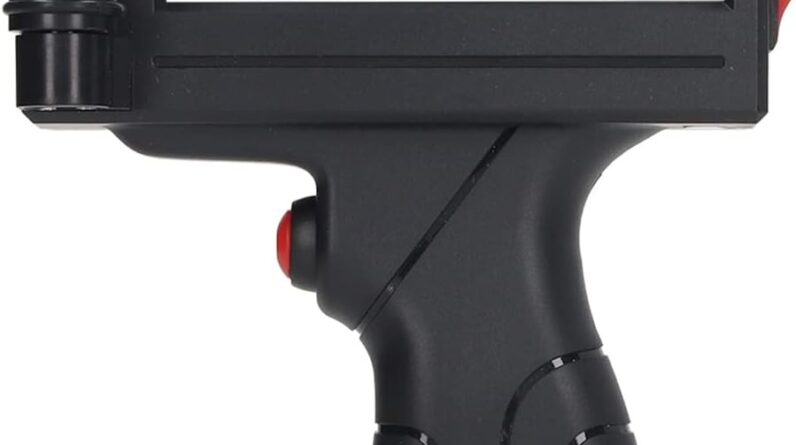
Disclaimer: This post may contain affiliate links. As an Amazon Associate, we earn from qualifying purchases.
Have you ever wondered how long an inkjet printer typically lasts before it needs to be replaced? Well, look no further! In this article, we will explore the average lifespan of an inkjet printer and provide you with some helpful tips to extend its longevity. Whether you use it for personal or professional purposes, understanding the lifespan of your printer can help you make informed decisions when it comes to buying a new one. So, let’s dive in and learn more about the average life of an inkjet printer!
Factors That Affect the Lifespan of an Inkjet Printer
Usage Frequency
One of the main factors that can significantly impact the lifespan of an inkjet printer is the frequency of its usage. Printers that are used more frequently tend to have a shorter lifespan compared to those that are used sparingly. This is because continuous use puts more strain on the internal components of the printer, leading to more wear and tear over time. If you have a high printing demand, it is advisable to consider purchasing a printer model that is specifically designed for heavy-duty usage.
Quality of Ink
The quality of ink used in an inkjet printer can also play a crucial role in determining its lifespan. Using poor-quality or third-party ink cartridges that are not compatible with your printer can lead to clogging of the printhead and other technical issues. These problems can significantly reduce the lifespan of your printer as they can cause irreversible damage to the internal components. It is recommended to always use genuine ink cartridges that are specifically designed for your printer model to ensure optimal performance and longevity.
Maintenance and Care
Proper maintenance and care are vital in extending the lifespan of your inkjet printer. Regular cleaning of the printer, especially the printhead, can prevent clogs and ensure smooth printing operation. It is important to follow the manufacturer’s guidelines for cleaning and maintenance to avoid any damage to the printer. Additionally, keeping the printer in a dust-free environment and avoiding exposure to extreme temperatures or humidity can also contribute to its longevity.
Environmental Factors
The environment in which the printer is used can impact its lifespan as well. Excessive exposure to dust, heat, or moisture can lead to damage to the internal components of the printer. It is advisable to place your printer in a clean and well-ventilated area, away from direct sunlight or other sources of heat. This will help to prevent the accumulation of dust and avoid any potential damage caused by environmental factors.
Average Lifespan of Inkjet Printers
Manufacturers’ Estimates
Most inkjet printer manufacturers provide an estimated lifespan for their products. However, it is important to note that these estimates are based on average usage and may vary depending on individual factors such as usage frequency and maintenance. The typical lifespan of an inkjet printer, according to manufacturers, can range from 3 to 5 years. However, with proper care and maintenance, it is possible to extend the lifespan of your printer beyond these estimates.
Customer Experiences
Customer experiences can provide valuable insights into the average lifespan of inkjet printers. While individual experiences may vary, many printer users have reported using their inkjet printers for 5 to 7 years or even longer before experiencing any major issues. These experiences highlight the importance of proper maintenance and care in maximizing the lifespan of your printer.
Warranty Periods
The warranty period offered by printer manufacturers can also give an indication of the expected lifespan of their products. Most inkjet printers come with a standard one-year warranty, which means that the manufacturer guarantees the printer’s performance for at least one year. Some manufacturers offer extended warranties as an option, providing coverage for a longer period. It is worth considering printers with longer warranty periods, as it can be an indication of the manufacturer’s confidence in the printer’s durability.

This image is property of images.unsplash.com.
Extending the Life of Your Inkjet Printer
Proper Handling and Storage
Proper handling and storage of your inkjet printer are crucial in maintaining its longevity. When handling the printer, it is important to avoid rough movements or dropping it, as this can cause damage to the internal components. When not in use, the printer should be stored in a safe and dry place to avoid exposure to dust or humidity. Additionally, it is advisable to cover the printer with a dust cover when it is not being used for an extended period of time.
Regular Cleaning
Regular cleaning of your inkjet printer is essential for optimal performance and longevity. The printhead should be cleaned regularly to prevent clogs and ensure the smooth flow of ink. This can be done using the printer’s built-in cleaning function or by manually cleaning the printhead with a lint-free cloth and printer cleaning solution. It is important to follow the manufacturer’s guidelines for cleaning to avoid any damage to the printer.
Using Genuine Ink Cartridges
Using genuine ink cartridges that are specifically designed for your printer model is highly recommended. Genuine cartridges ensure compatibility with your printer and help to maintain the integrity of the printhead. Third-party or compatible ink cartridges may be cheaper, but they can sometimes cause clogs or damage to the printer, leading to a shorter lifespan. Investing in genuine ink cartridges is a worthwhile investment in the long run to protect the longevity of your inkjet printer.
Avoiding Paper Jams
Paper jams can not only be frustrating but also potentially damaging to your printer. Frequent paper jams can put strain on the internal components, leading to premature wear and tear. To avoid paper jams, make sure to use the correct type and size of paper recommended by the printer manufacturer. It is also important to properly load the paper and avoid overfilling the paper tray. Regularly cleaning the paper path and rollers can also help prevent paper jams.
Avoiding Overuse
Overusing your inkjet printer can contribute to a shorter lifespan. Continuous and excessive print jobs can put a strain on the printhead and other parts of the printer, leading to faster wear and tear. It is important to use your printer judiciously and avoid unnecessary print jobs. If you have a large printing task, consider breaking it down into smaller batches and allowing the printer to rest between printing sessions to prevent overheating.
Updating Firmware and Drivers
Regularly updating the firmware and drivers of your inkjet printer is important to ensure optimal performance and compatibility with the latest software. These updates often include bug fixes and improvements that can enhance the lifespan and functionality of your printer. Manufacturers typically provide firmware and driver updates on their websites, and it is advisable to check for updates periodically and install them as recommended.
Warning Signs of a Failing Inkjet Printer
Print Quality Decline
One of the first warning signs that your inkjet printer might be nearing the end of its lifespan is a decline in print quality. If you start noticing streaks, smudges, or faded areas in your prints, it could be a sign of a deteriorating printhead or other internal issues. While occasional print quality issues can be resolved with maintenance or printhead cleaning, consistent decline in print quality may indicate that it’s time to consider replacing your printer.
Frequent Paper Jams
If you are experiencing frequent paper jams, even after taking preventive measures mentioned earlier, it could be a sign of an underlying issue with the printer. Continuous paper jams can put strain on various components and cause damage over time. If paper jams become a recurring problem despite proper maintenance, it might be a sign that your printer is nearing the end of its lifespan.
Error Messages
Persistent error messages or error codes can indicate a failing inkjet printer. These messages may signify problems related to the printhead, ink cartridges, or other internal components. While some issues can be resolved with troubleshooting and maintenance, frequent or unresolved error messages may indicate that the printer is reaching the end of its usable life.
Unusual Noises
Unusual or loud noises during the printing process can also be a warning sign of a failing inkjet printer. Grinding, squeaking, or banging noises can indicate internal mechanical issues or damage to moving parts. These noises should not be ignored, as they can indicate that the printer is experiencing significant wear and tear and may be approaching the end of its lifespan.
Ink Leakages
If you notice ink leakages or smears inside your inkjet printer or on your printed documents, it is a clear indication of a problem. Ink leakages can damage the internal components of the printer and affect print quality. While occasional ink smears can be attributed to normal usage, persistent leakages are a serious issue and may suggest that your printer needs to be replaced.

This image is property of images.unsplash.com.
When to Consider Replacement
Cost of Repair
When considering whether to repair or replace your inkjet printer, one of the key factors to consider is the cost of repair. If the cost of repairing your printer exceeds a certain threshold, it may be more cost-effective to invest in a new printer. This threshold can vary depending on the specific printer model and its current market value. It is advisable to consult with a printer technician or compare the cost of repair with the price of a new printer before making a decision.
Frequent Malfunctions
If you find yourself dealing with frequent malfunctions or recurring issues with your inkjet printer, it may be a sign that it is reaching the end of its usable life. Constant breakdowns and repairs can be time-consuming and frustrating, especially if they disrupt your workflow or productivity. In such cases, it might be worth considering replacement to avoid the hassle and uncertainty of ongoing printer problems.
Obsolete Technology
As technology advances, older printer models can become obsolete and outdated. If your inkjet printer lacks compatibility with the latest software updates or does not have the features or connectivity options required for your current needs, it may be time to consider upgrading to a more advanced printer. Newer models often offer improved performance, energy efficiency, and connectivity options, making them a better long-term investment.
Increased Printing Needs
Another factor that may influence the decision to replace your inkjet printer is an increase in your printing needs. If your current printer is unable to keep up with your growing demands in terms of speed, volume, or quality, it may be time to consider a printer that is better suited to your requirements. Investing in a printer that matches your printing needs will ensure efficiency and productivity in the long run.
Pros and Cons of Replacing vs Repairing
Financial Considerations
When deciding between replacing or repairing your inkjet printer, financial considerations play a significant role. While repairs may seem like a more cost-effective option initially, they can add up over time, especially if your printer requires frequent repairs. On the other hand, purchasing a new printer involves a higher upfront cost but may offer better long-term value, especially if you choose a model that is durable and equipped with the features you require.
Environmental Impact
Another important aspect to consider when deciding between replacing or repairing your inkjet printer is the environmental impact. Repairing and maintaining your current printer can help reduce electronic waste and minimize your carbon footprint. However, if your printer is outdated or beyond repair, replacing it with a more energy-efficient and eco-friendly model can contribute to overall sustainability. It is important to weigh the environmental impact against your specific printing needs and budget.
Technological Upgrades
Replacing your inkjet printer offers an opportunity to upgrade to the latest technological advancements. Newer printer models often come with enhanced features such as wireless connectivity, mobile printing capabilities, and improved print quality. Upgrading to a printer that aligns with your current technological needs can improve your printing experience and provide better compatibility with the devices and software you use.
Print Quality and Efficiency
Repairing an older inkjet printer may not always guarantee improved print quality or efficiency. As printers age, they may experience a decline in performance and print quality due to wear and tear of internal components. On the other hand, replacing your printer with a newer model can offer superior print quality, faster printing speeds, and more efficient operation. Assessing your current and future printing needs can help determine whether upgrading to a new printer is the right choice for you.
Tips for Choosing a Long-lasting Inkjet Printer
Researching Reliable Brands
When selecting an inkjet printer that is built to last, it is important to research and choose from reliable and reputable brands. Established brands often have a track record of producing durable and high-quality printers. Reading customer reviews, expert opinions, and researching industry ratings can give you valuable insights into the reliability and longevity of different printer models.
Considerations for Specific Needs
Consider your specific printing needs and requirements before choosing an inkjet printer. Different printers are designed for different purposes, such as home office use, professional photo printing, or high-volume printing for businesses. Assess factors such as printing speed, paper size compatibility, connectivity options, and print quality to find a printer that meets your unique needs and has the durability to withstand your expected usage.
Reading Customer Reviews
Customer reviews can offer honest and unbiased feedback on the performance and durability of inkjet printers. Reading reviews from users who have used the printer model you are considering can provide valuable insights into its lifespan and reliability. Look for patterns or recurring issues mentioned in the reviews that may indicate potential longevity or quality concerns.
Assessing Product Specifications
Take the time to carefully review the product specifications and features of inkjet printers before making a purchase. Look for details such as the recommended monthly duty cycle, suggested print volume, and supported paper sizes and types. These specifications can give you an idea of the printer’s durability and ability to handle your specific printing needs. Additionally, check if the printer has any warranty coverage to provide an added layer of protection for your investment.
How to Prolong the Life of Your Inkjet Printer
Using High-Quality Ink
Using high-quality ink that is specifically designed for your printer model is crucial in prolonging the life of your inkjet printer. Genuine ink cartridges ensure compatibility and optimal performance, preventing clogs and damage to the printhead. Although genuine cartridges may be more expensive compared to third-party options, they offer better print quality and help maintain the longevity of your printer.
Avoiding Overuse and Excessive Print Jobs
Avoiding overuse and excessive print jobs can help extend the lifespan of your inkjet printer. Continuous and prolonged usage can put strain on the printer’s internal components, leading to faster wear and tear. It is important to use your printer judiciously and only print when necessary. If you have a large print job, consider breaking it down into smaller batches and allow the printer to rest between sessions to prevent overheating.
Scheduled Maintenance
Regularly scheduled maintenance is key to keeping your inkjet printer in optimal condition. Follow the manufacturer’s guidelines for cleaning and maintenance, including routine printhead cleaning and replacing or refilling ink cartridges when necessary. This will help prevent clogs, maintain print quality, and ensure the longevity of your printer.
Proper Transportation and Storage
If you need to transport your inkjet printer or store it for a prolonged period, it is important to ensure proper handling and storage. Before transporting, secure all movable parts, remove the ink cartridges, and pack the printer in its original packaging or a protective case. When storing the printer, choose a cool and dry place, and cover it with a dust cover to protect it from dust and other environmental factors that could potentially damage the printer.
Common Inkjet Printer Problems and Solutions
Nozzle Clogging
Nozzle clogging is a common problem faced by inkjet printer users. Clogged nozzles can result in print quality issues such as streaks or missing colors in the printed output. To resolve nozzle clogging, most printers have a built-in cleaning function that can be accessed through the printer’s settings menu. Running the printhead cleaning cycle can help dislodge any dried ink or debris that may be causing the clog. If the problem persists, a deeper printhead cleaning or manual cleaning with a lint-free cloth and printer cleaning solution may be required.
Paper Jams
Paper jams occur when paper gets stuck in the printer’s paper path and cannot move freely. To resolve paper jams, it is important to follow the printer’s instructions for clearing paper jams. This usually involves gently removing any stuck paper, checking and cleaning the paper path and rollers, and ensuring that the paper is properly loaded and not overfilled. Regularly cleaning the paper path with a lint-free cloth and ensuring that the paper is stored in a dry environment can help prevent paper jams.
Ink Cartridge Issues
Ink cartridge issues, such as unrecognized or empty cartridge error messages, can be frustrating. To resolve these issues, make sure that the ink cartridges are properly installed and seated in their respective slots. If an ink cartridge is empty, replace it with a new one. If the printer continues to show error messages, try removing and reinserting the ink cartridges or cleaning the electrical contacts on the cartridges and inside the printer. If the problem persists, it may be necessary to consult with the printer manufacturer or a technician for further assistance.
Connectivity Problems
Connectivity problems can prevent the printer from being recognized by the computer or other devices on the network. To troubleshoot connectivity issues, ensure that the printer is properly connected to the computer or network, and check the printer’s settings to ensure that it is set to the correct connection type (such as USB or wireless). Restarting the printer and the computer or resetting the network settings on the printer can often resolve minor connectivity issues. If the problem persists, it may be necessary to update the printer’s firmware or consult with the printer manufacturer for further assistance.
Routine Maintenance for Inkjet Printers
Cleaning the Printhead
Regular cleaning of the printhead is important for maintaining print quality and preventing clogs. Most inkjet printers have a built-in printhead cleaning function accessible through the printer’s settings menu. Running the printhead cleaning cycle as recommended by the manufacturer can help dislodge any dried ink or debris that may be clogging the nozzles. For a deeper clean, some printers offer a deep printhead cleaning option or manual cleaning with a lint-free cloth and printer cleaning solution.
Replacing or Refilling Ink Cartridges
Regularly replacing or refilling ink cartridges is necessary to ensure uninterrupted printing and optimal print quality. When an ink cartridge runs out of ink, replace it with a new one that is compatible with your printer model. If you are using refillable cartridges, follow the manufacturer’s instructions for refilling them with high-quality ink. It is important to avoid letting the ink cartridges run completely empty, as this can lead to air entering the printhead and causing clogs or print quality issues.
Aligning and Calibrating the Printer
Aligning and calibrating the printer is an important maintenance step to ensure accurate and consistent print quality. Most inkjet printers have an alignment and calibration function that can be accessed through the printer’s settings menu. Running the alignment and calibration process as recommended by the manufacturer helps to align the printhead with the paper and adjust color settings for optimal print quality. It is advisable to perform alignment and calibration after installing new ink cartridges or when you notice any print quality issues.
Clearing Paper Paths and Rollers
Clearing the paper paths and rollers is essential for preventing paper jams and maintaining smooth paper feeding. Regularly check the paper path and remove any debris or stuck paper that may be blocking the path. Wipe the paper path and rollers with a lint-free cloth to remove any dust or residue that could cause paper feeding issues. It is recommended to follow the instructions provided by the printer manufacturer for specific guidance on clearing paper paths and rollers.






